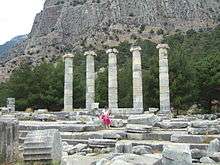Pythius of Priene
Pythius (Greek: Πύθιος), also known as Pytheos (Greek: Πυθεός) or Pythis, was a Greek architect of the 4th century BC. He built the Temple of Athena Polias cited by Vitruvius (I.1.12): "Pythius, the celebrated builder of the temple of Minerva at Priene".[1]

Pythius disparaged the Doric order, according to Vitruvius (IV.3.1), for the "faults and incongruities" caused by the inconvenient placing of triglyphs,[2] and cultivated instead the Ionic order used extensively in Asia Minor. The dedicatory inscription, of the Temple of Athena which today is in the British Museum, records that the founder was Alexander the Great. Vitruvius (I.1.12 and VII.Introduction.12) twice mentions the lost Commentaries of Pythius, which explicated his system of proportions at Priene.
Pythius and Satyros were the co-designers of the great Mausoleum at Halicarnassus on the Aegean Sea opposite Greece, with Pythius being credited with the great marble quadriga which surmounted the mausoleum.
References
- Banister Fletcher, A History of Architecture on the Comparative Method, p.31
- The faults were noted also by architect theorists Arcesius and Hermogenes, according to Vitruvius.
